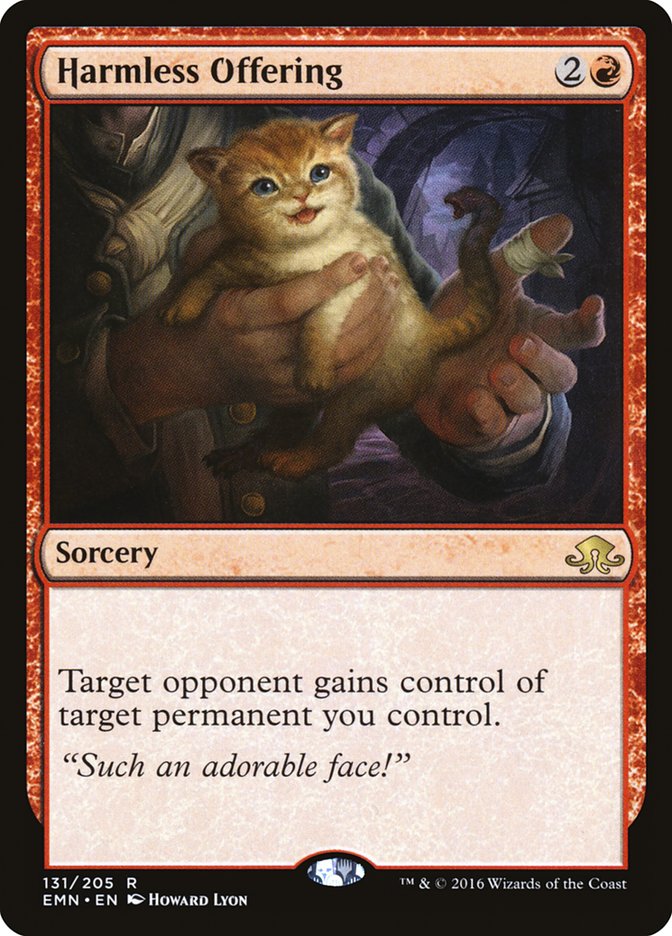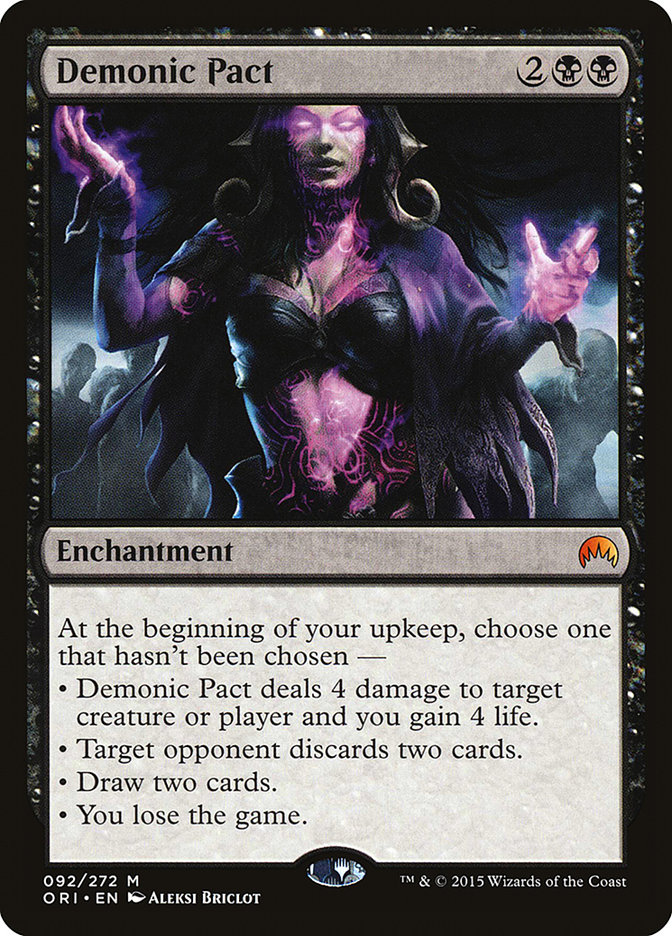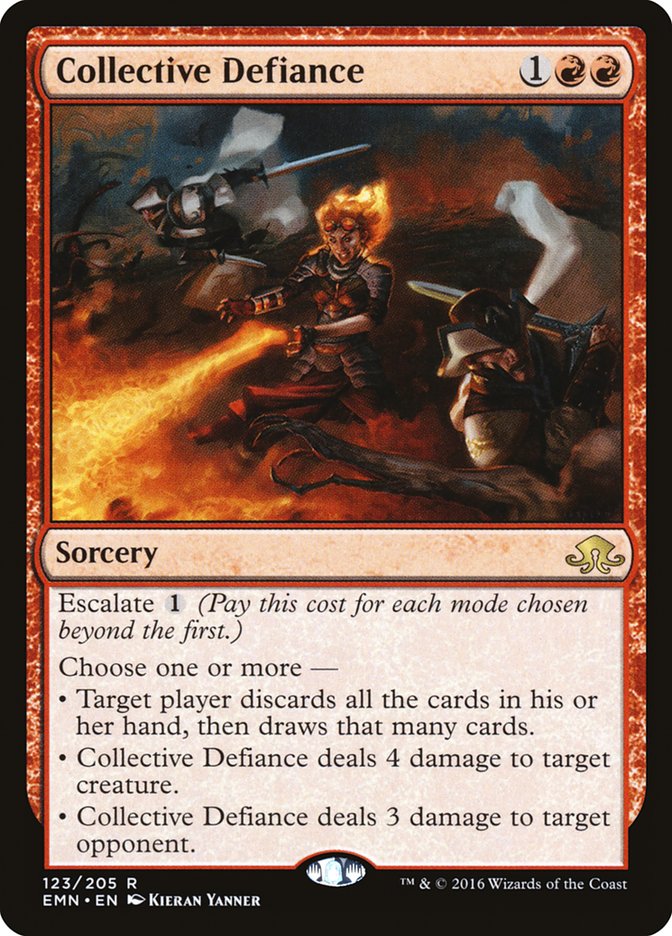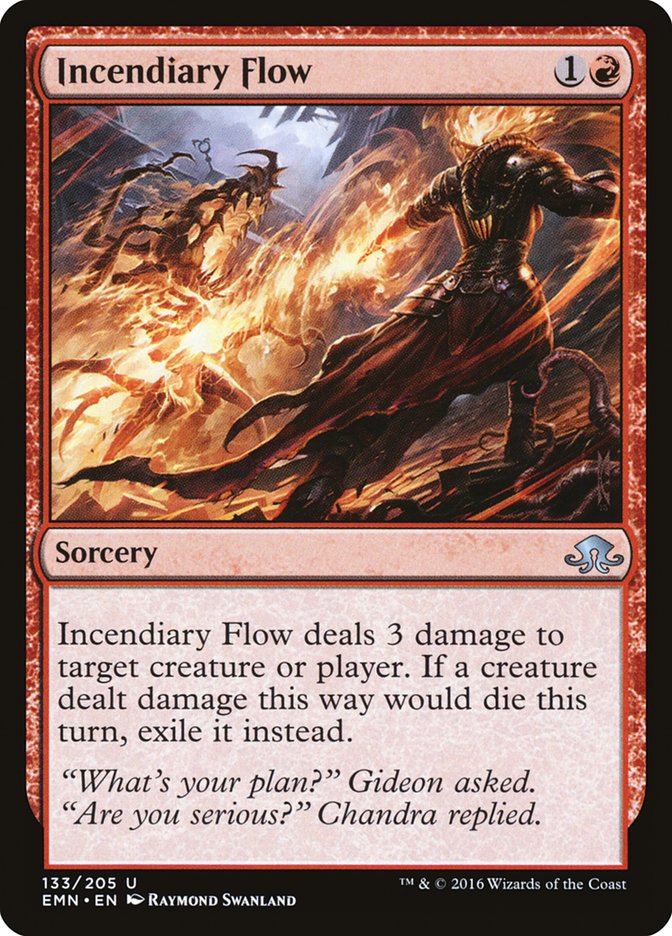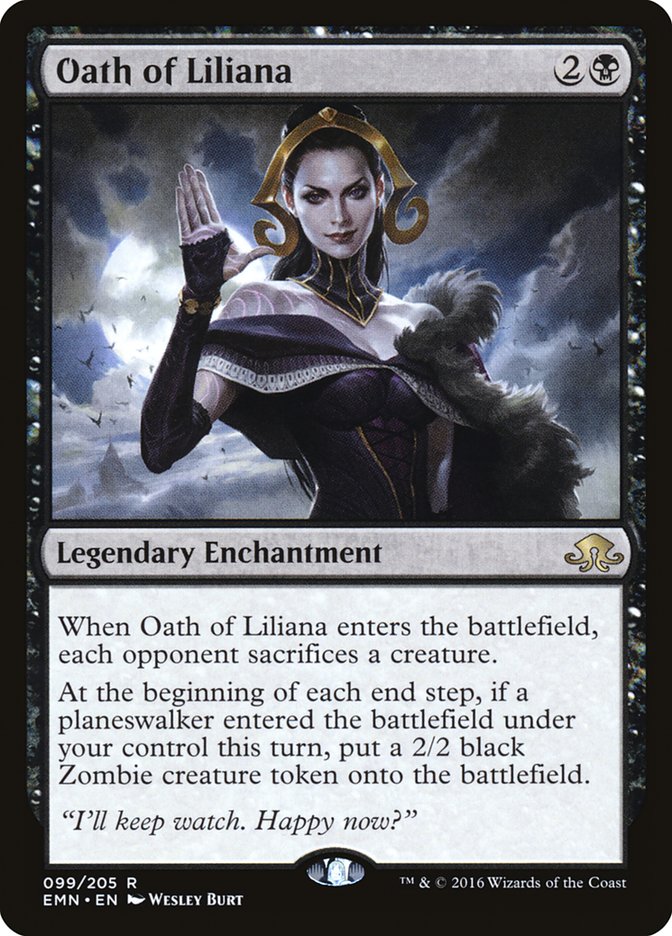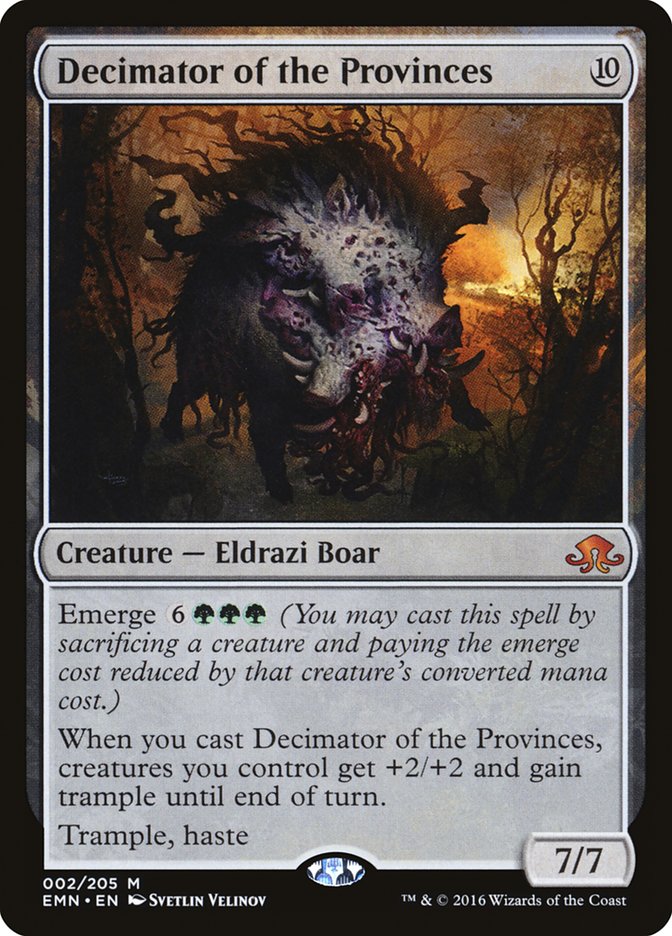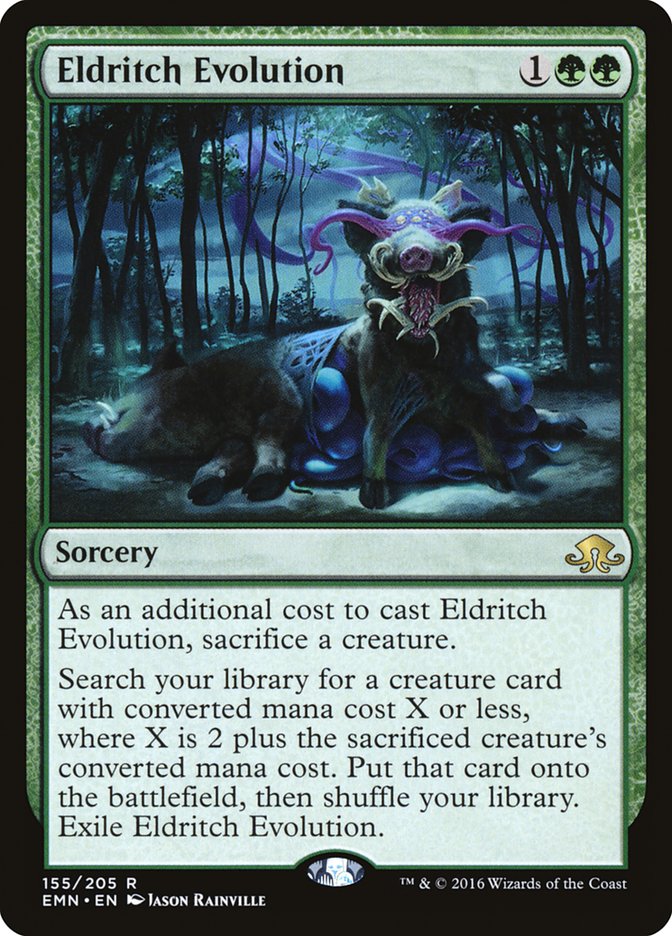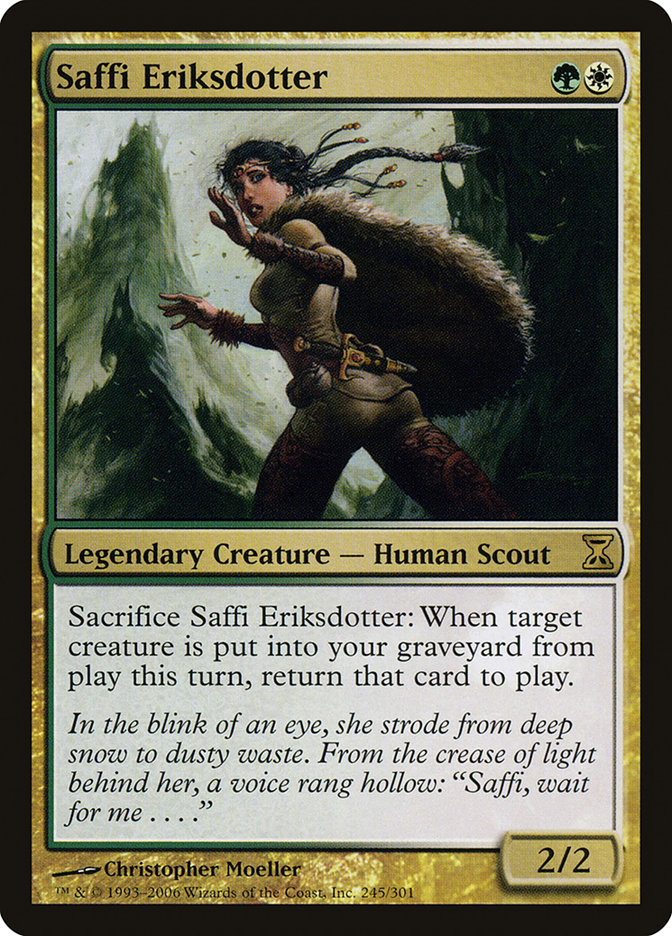Magic is hard.
No, seriously, despite a relatively intuitive set of rules, Magic is a deceptively complex game. The depth of Magic is what tends to make up the differences between an average player and a great player.
Generally speaking, in Magic there is always a greater power. There’s almost always going to be someone who is better than any given player at a specific dynamic of Magic. Seth Manfield may be the best player in the world right now, but that doesn’t mean he is better at playing Legacy Miracles than Joe Lossett.
Understanding who is favored in any given matchup is incredibly contextual. Being better at the game improves one’s odds at winning in the face of adversity, but it’s hardly a skeleton key.
The Big Key to Circumvention
Combo decks are a fantastic way to close a gap in skill between oneself and a much better player. Sure, your opponent may be better at handling their planeswalkers or more proficient at creature combat, but if you have 1,000,000 Restoration Angel tokens courtesy of Kiki-Jiki, Mirror Breaker, it doesn’t really matter how much better or worse at Magic the opponent is.
The biggest reason that combo decks hold so much power is that they allow the pilot of the deck to choose the context in which players will be fighting. The most successful linear combo decks can’t be interacted with via normal means and create a game state that is generally favorable for the combo itself. Take Stanislav Cifka’s Pro Tour-winning deck from PT Return to Ravnica:
Lands (17)
Spells (43)
- 3 Sleight of Hand
- 4 Serum Visions
- 4 Second Sunrise
- 4 Conjurer's Bauble
- 4 Reshape
- 1 Pyrite Spellbomb
- 4 Chromatic Sphere
- 4 Chromatic Star
- 4 Lotus Bloom
- 4 Elsewhere Flask
- 2 Silence
- 1 Gitaxian Probe
- 4 Faith's Reward
Sideboard

This deck is a bit hard to understand at first glance, but let me explain how the deck works:
Step 1: Play lands and a few “Eggs,” artifacts that sacrifice themselves without a net loss in mana.
Step 2: Get Lotus Bloom on the battlefield either by resolving it from Suspend OR Reshape with an X value of zero.
Step 3: Begin cycling through the deck by sacrificing the aforementioned Eggs.
Step 4: Cast Second Sunrise or Faith’s Reward to return all of the sacrificed cards (including a Lotus Bloom) to the battlefield.
Step 5: Repeat Steps 1-4 until the entire library is nothing but copies of Faith’s Reward and Second Sunrise.
Step 6: Use Conjurer’s Bauble to ensure the Eggs pilot never decks out. Use a copy of Lotus Bloom for red mana. Use the mana to Shock the opponent with Pyrite Spellbomb. Repeat until the opponent is at zero life.
This all sounds incredibly complicated but is made easier by the fact that there aren’t many cards with the ability to properly interact with the combo. Creature removal doesn’t stop the deck from comboing, and with the ability to combo as soon as turn 3, the deck has fantastic racing potential.
Second Sunrise has since been banned in Modern due to the deck’s speed, resiliency to hate, and consistency. Very few combos are quite as powerful in the context of their respective formats, but Eldritch Moon provides a good number of combo-enablers that have similar levels of difficulty to interact with.
It’s hard to avoid the buzz surrounding Harmless Offering, and for good reason. A combo deck revolving around Donate and Illusions of Grandeur effectively ruined an entire format; being the first to come up with a similar brew in today’s Magic world is the kind of stuff that legends are made of.
The most effective Standard-legal combo with Harmless Offering involves selecting everything on Demonic Pact (over the course of three turns) except the “You lose the game” ability. At this point the Demonic Pact is Offered to the opponent, who is then forced to lose the game on their next upkeep!
So far the only deck requirements of the deck are:
· Must be black for Demonic Pact and red for Harmless Offering.
· Must be heavily black to ensure an earlier Demonic Pact; this is because it takes 3 turns after the Pact is deployed for Harmless Offering to successfully force someone to lose the game.
The desire to have an early Demonic Pact means that the deck will have to play three or more copies of the enchantment while putting itself in a position to effectively take turn 4 off. If the deck is able to survive the fourth turn without impacting the battlefield (after casting Demonic Pact) it should be in great shape by either drawing two cards to keep itself alive or destroying a problematic creature while gaining four life.
This need to survive while playing several cards that don’t do anything outside of the combo (read: Harmless Offering) means the deck will have to play copious amounts of removal to ensure survival until the combo takes hold. Luckily today’s Standard isn’t short on reasonable removal spells suited to the needs of this deck:
This doesn’t even factor in some of the goodies that Eldritch Moon is giving us. Red removal in particular is getting a particularly juicy set of tools to work with:
Creatures (1)
Planeswalkers (2)
Lands (26)
Spells (31)

Despite being more linear than most of today’s Standard decks, this particular list has the benefit of blanking a lot of cards in other decks. Even though it’s a creature, Dragonlord Silumgar functions more as an over-the-top Dark Petition target that can preemptively steal a planeswalker’s ultimate.
The addition of blue to the archetype is for a handful of Dark Petition options as well as a way to reset Demonic Pact in the form of Silumgar’s Command. There are several different directions that this deck could go and it’s hard to say that this is much better than a Mardu-colored variant that uses Angelic Purge to get rid of Demonic Pact after using it to net some cards and life.
Invalidating a number of the opponent’s cards can be a way to net a pretty easy victory against an unprepared opponent but can backfire in a big way. Many decks that bank on blanking cards in other players’ decks tend to do it by reducing the number of angles they attack from to a single focus. If the opponent isn’t prepared they’ll effectively be unable to compete. The caveat to this is that if the opponent is prepared to fight against the deck’s weapon of choice–an enchantment in this example–then it will be incredibly difficult for the combo pilot to win.
Drawing from the initial example of Kiki-Jiki, Mirror Breaker and Restoration Angel, another way that combo decks can function is by planning to go so far over-the-top that a deck trying to operate on a normal axis won’t be able to compete. These are the types of decks that may not always be described as combo decks but have a tendency to attack for 30 or more damage or produce more than fifteen creatures on the battlefield at one time.
This big Boar tends to strike me as a card that will be a very welcome addition to the growing number of Cryptolith Rite decks that keep evolving and adapting to each shape that the metagame tends to take. Team MGG’s Danny Jessup recently finished in the Top 8 of the SCG Tour®‘s Open in Orlando with a variant of the Rite archetype that would be a very welcoming home to the new Boar on the block.
Creatures (26)
- 4 Elvish Visionary
- 1 Dragonlord Atarka
- 1 Nissa, Vastwood Seer
- 4 Reflector Mage
- 4 Eldrazi Displacer
- 4 Matter Reshaper
- 4 Duskwatch Recruiter
- 4 Loam Dryad
Planeswalkers (2)
Lands (24)
Spells (8)
Sideboard

For anyone who didn’t play Standard during Avacyn Restored Standard, Craterhoof Behemoth was an amazing finisher that helped creature-based midrange decks punch through stalled battlefield states. This deck uses Dragonlord Atarka as a finisher that tries to accomplish the same goal, but it doesn’t always seal the deal.
Outside of the standout synergy with Cryptolith Rite making Decimator of the Provinces easier to cast, it is hard to ignore the sort of Ritual effect that Matter Reshaper can provide with Decimator of the Province’s emerge ability.
The biggest issue that could arise in this scenario is that the amount of green mana that this ability requires on top of the mana cost itself (even subtracting Matter Reshaper’s converted mana cost of three) is still hefty. This is reminiscent of another take on the archetype with slightly better mana but fewer tricks up its sleeve:
Creatures (30)
- 4 Nantuko Husk
- 4 Elvish Visionary
- 2 Liliana, Heretical Healer
- 4 Catacomb Sifter
- 4 Blisterpod
- 4 Zulaport Cutthroat
- 4 Duskwatch Recruiter
- 4 Loam Dryad
Lands (22)
Spells (8)

This deck is a bit weaker to Kalitas, Traitor to Ghet than the versions packing Reflector Mage and Nahiri, the Harbinger, but the explosiveness coupled with the efficiency makes it an incredibly attractive option post-Eldritch Moon.
I’ll start playtesting for #SCGCOL here:
Creatures (29)
- 3 Nantuko Husk
- 4 Elvish Visionary
- 4 Catacomb Sifter
- 4 Blisterpod
- 4 Zulaport Cutthroat
- 4 Duskwatch Recruiter
- 4 Loam Dryad
- 2 Decimator of the Provinces
Lands (23)
Spells (8)

The only substantial changes from my list in Milwaukee and this are the removal of two Liliana, Heretical Healers for two Decimator of the Provinces and the removal of a Nantuko Husk for a Forest in order to support the Eldrazi.
One aspect of combo decks that can be aggravating from a deckbuilder’s prospective is how little wiggle-room there can be within a deck. Part of proficiently building and piloting a deck is understanding how the deck plans to execute its primary gameplan against any given opponent. This is even more important in a combo deck, as there are generally many different things that need to go right in order for the deck to “do its thing,” so-to-speak.
When adding new cards or subtracting old cards from a combo deck, it can be easy to fall into the trap of doing what’s called “trimming numbers.” Instead of identifying what roles different cards play and how to most effectively maximize a deck’s capabilities, a single copy or two copies of several different cards are removed. Instead of just trimming numbers, it is absolutely essential to understand the function of each proverbial cog in the machine.
A common approach to ensuring the resolution of a combo is just to make the combo itself have as much redundancy as possible. This is achieved by being able to attempt a combo as many times in a single game as possible in order to force the combo’s success. Omni-Tell’s success with Dig Through Time is a sterling example of this theory:
Creatures (2)
Lands (18)
Spells (40)

This deck had one plan: resolve Show and Tell to put Omniscience on the battlefield. Period. From there it had multiple avenues to victory, but it all started with getting an impossibly expensive enchantment from the hand to the battlefield.
This card frightens me with how many ways it can be broken. Nobody is contesting the power of Birthing Pod in Modern (hence its residency on the banlist) and this tends to one-up Birthing Pod in several situations.
My inclination is to revive the long-dead Project X deck of yesteryear’s Standard format and port it to Modern:
Creatures (26)
- 1 Eternal Witness
- 1 Teysa, Orzhov Scion
- 1 Crypt Champion
- 3 Saffi Eriksdotter
- 1 Reveillark
- 2 Viscera Seer
- 4 Blood Artist
- 1 Cartel Aristocrat
- 4 Voice of Resurgence
- 4 Blisterpod
- 4 Zulaport Cutthroat
Lands (22)
Spells (12)

This particular deck tends to have a singular gameplan: win with Blood Artist and Zulaport Cutthroat effects. There are a couple of different ways to accomplish this goal and it’s hard to tell which version is more efficient at this point.
The first is using Return to the Ranks in conjunction with Viscera Seer and Cartel Aristocrat. After sacrificing everything on the battlefield to generate several life-draining triggers with the latter creatures, the aforementioned instant then returns them all to the battlefield to be sacrificed again.
The second combo is where Eldritch Evolution works so spectacularly. On top of being able to grab pseudo-silver bullets in Eternal Witness and Reveillark, Eldritch Evolution can find an infinite combo that interacts with the various Blood Artists that the deck is packed full of.
The goal is to have a Blood Artist-styled creature on the battlefield and another two-drop creature on the battlefield with Saffi Eriksdotter either on the battlefield or in the graveyard. From there an Eldritch Evolution or Chord of Calling can find Crypt Champion. When Crypt Champion enters the battlefield, it returns a creature to the battlefield and sacrifices itself because red mana wasn’t spent to cast it. With the sacrifice trigger on the stack, sacrifice Saffi Eriksdotter targeting Crypt Champion.
When Crypt Champion dies, it returns to the battlefield. Upon its reentry to the battlefield, stack the triggers to have the reanimation trigger resolve before the sacrifice trigger (with the reanimation trigger targeting the recently-deceased Saffi). When Saffi returns to the battlefield, sacrifice her, targeting Crypt Champion. Rinse and repeat the loop until the opponent dies from Blood Artist triggers.
Eldritch Evolution productively searching for each piece of the combo while contributing to the overarching theme of the archetype, coupled with the synergies in the deck itself, really makes this an incredibly attractive option for the post-Eldritch Moon Modern world. Chord of Calling serves as another form of Eldritch Evolution (albeit a slightly harder-to-cast version) that helps this deck have nine-plus copies of every single combo piece in the deck. Viscera Seer’s ability being more than just a sacrifice outlet is also something that shouldn’t be ignored.
Resiliency, reducing the opponent’s ability to interact, and indifference towards the opponent’s interaction are all factors that contribute to the power of combo decks and their ability to contribute to one’s personal success. Harnessing these ideas and applying them to your own deckbuilding will do nothing short of taking it to then next level.
All of these ideas tend to focus on a central idea: understand what weapon you’re bringing to battle. Magic tends to be an arms race in its own right, and being sure that you’re properly equipped is the best way to ensure your success.


